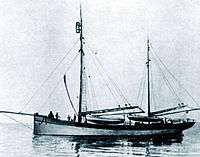Vladimir Rusanov
Vladimir Alexandrovich Rusanov (Russian: Влади́мир Алекса́ндрович Руса́нов; 3 November [O.S. 15 November] 1875, Oryol – ca. 1913) was an experienced Russian geologist who specialized in the Arctic.
In 1909–1911 V. A. Rusanov carried out explorations in Novaya Zemlya. He was helped by Tyko Vylka, his guide, who later became the Chairman of the Novaya Zemlya Soviet.
In 1912 Rusanov had been appointed to command a government expedition to Svalbard to investigate the coal potential.[1] He sailed from Aleksandrovsk-na-Murmane (now Polyarnyy, near Murmansk) on 26 June on ship Gerkules under Captain Alexander Kuchin, Roald Amundsen's South Pole navigator. The personnel consisted of thirteen men and one woman, Rusanov's French fiancée Julie Jean. Apart from Rusanov there was another geologist and a zoologist.
At the end of a very successful summer’s field work, three members of the expedition (the geologist, the zoologist and the ship's bosun) returned to Russia via Grønfjorden in Norway.[2] The remaining ten, however, without consultation with the authorities in St. Petersburg, set off with Rusanov in an incredibly rash attempt at reaching the Pacific Ocean via the Northern Sea Route. Their ship Gerkules was too small for the kind of expedition Rusanov had in mind.
The last to be heard of Rusanov's expedition was a telegram left at Matochkin Shar on Novaya Zemlya, which reached St. Petersburg on 27 September 1912. In it, Rusanov indicated that he intended rounding the northern tip of Novaya Zemlya, and heading east across the Kara Sea but nothing was heard from the Gerkules thereafter. He and his 11-man team, including Alexander Kuchin, disappeared without trace a year later in the Kara Sea, off the northern coast of Siberia.

In 1914-15 the almost impossible task of searching for Rusanov (as well as for the similarly disappeared Captain Georgy Brusilov and the Brusilov Expedition), was entrusted to Otto Sverdrup with the ship Eklips. His efforts, however, were unsuccessful.
In 1937 the Arctic Institute of the Soviet Union organized an expedition to the Nordenskiöld Archipelago on ship Toros. Relics of the ill-fated 1912-13 Vladimir Rusanov’s expedition on the Gercules were found on Popova-Chukchina Island located at (74° 56'N, 86° 18'E) off Kolosovykh Island in the Kolosovykh group.
A glacier in October Revolution Island, in the Severnaya Zemlya group has been named after Vladimir Rusanov.
Rusanov is dutifully remembered in the city of his birth, Oryol, where the Rusanova Street is named after him. There is also a museum in the house where he spent his childhood and youth at no. 43 Rusanova Street. The cabin Rusanov built on Svalbard in 1912 (Rusanovodden) was turned into a small self-guided museum.
Soviet coal mining on Svalbard began in 1932.
References
Sources
- William Barr, Otto Sverdrup to the rescue of the Russian Imperial Navy.
- William Barr, The First Tourist Cruise in the Soviet Arctic.